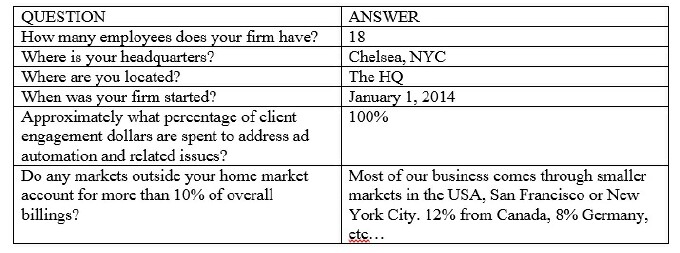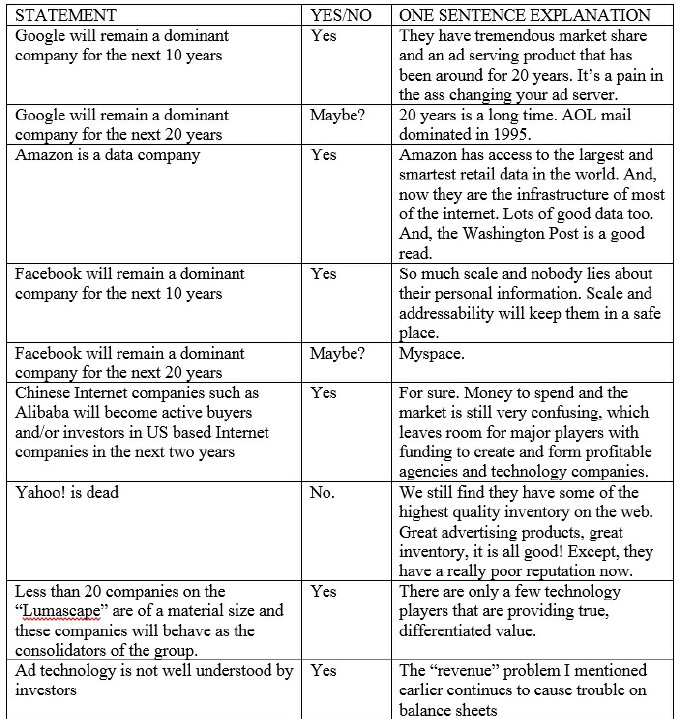Keith Gooberman of Programmatic Mechanics: The Ad Automation and Programmatic Confidantes

In a series of conversations with the leading confidantes and consultants in the ad automation and programmatic area, Jay Sears, Senior Vice President Marketplace Development of Rubicon Project, discusses trends and issues of the day impacting advertisers and media owners. Here, Sears speaks with Keith Gooberman, CEO of the independent trading desk Programmatic Mechanics. Gooberman started the company in 2014 after stints with MDC’s trading desk Varick Media, Glam Media and Conde Nast. [Editor's note: Be sure to read the first four parts of this series: Jay's interviews with Joe Weaver of Promatica Consulting, Matt Prohaska of Prohaska Consulting, Matt Spiegel of MediaLink and Joe Lampert of Edge Technology Services.]
JAY SEARS: What do you read to keep up with politics, art and culture?
KEITH GOOBERMAN: The New York Times
SEARS: What do you read to keep up with friends?
GOOBERMAN: ESPN, Crains
SEARS: What do you read to keep up with the advertising technology industry?
GOOBERMAN: AdExchanger, Mediapost, Exchange Wire, Digiday, Ad Age, etc.
SEARS: What’s your favorite commercial of all time?
GOOBERMAN: The Love Toilet
SEARS: With regards to advertising automation, what are the three biggest trends you expect to impact companies in 2016?
GOOBERMAN:
- Margin consolidation amongst the display, video, social and native players will continue and likely begin to accelerate as the technology becomes relatively commoditized.
- Continuing stock slide for many of the “ad technology” companies: Venture Capitalists will become smarter about the analysis between “Managed Advertising Spend” and “Revenue” ultimately leading to a clearer divide between true technology companies and service based ad networks.
- Snapchat: First comes scalable user base, second comes ad measurement and a platform, and then comes explosion of valuable inventory and the introduction of another major digital player.
SEARS: With regards to advertising automation, what are the three most overblown topics that you wish would just go away?
GOOBERMAN:
- Fraud. Anyone who does not have a partner who is constantly digging through the log level data in order to identify fraud is not doing it correctly. Or overlay a few fraud solutions, do it yourself, or move on.
- Viewability: If advertisers and brands implemented correct attribution models, then ads that don’t get seen cannot improve performance. Are we on mars? How could anyone claim that a non-viewable impression impacted anything?
- “The Banner is Dead”: The banner is not dead. It is not sexy, but it works if you know what you are doing. And, because of the scale and pricing, it can fit into any media plan providing true, attributable lift. But, again, it is not sexy.
SEARS: Please describe your firm.
GOOBERMAN: We are an “independent media trading desk.” We are the service layer sitting on top of DSP technology. We claim to be the “best traders in the business.” We tout ourselves as the “best providers of programmatic space” to brands, media companies, agencies, etc. We’re fully transparent on costs and our technology and techniques. And, we’re animals about understanding and sharpening the margins through the supply chain to show how we clean it up and provide value. We sell our solution through insertion orders, co-managed self service solutions with a variety of DSP partners, or simply “staffing traders” at companies who need the talent and want to “own the DSP” seat but cannot find talented traders to handle the business. Display, video, mobile, native.
SEARS: Tell us about your firm.
GOOBERMAN:

SEARS: What are the three most common issues you help clients on with respect to advertising automation and programmatic trading?
GOOBERMAN:
- Understanding the margins and the supply chain: Fully teaching clients how to think about the technology providers and identify places for improvement of exchange based ad placement.
- Separation of remarketing and prospecting:Helping clients correctly prospect for new customers and “web or mobile traffic” and setting up dynamic remarketing strategies to correctly utilize first-party data. And, really making sure clients understand the difference.
- Understanding the difference in service layer quality:Making sure clients can really understand the difference a data-scientist trader using great tools can really make in the success of programmatic plans.
SEARS: The majority of ad technology companies (relatively small, unprofitable or both) have struggled. Of the poor performers, what are the commonalities between them that have contributed to this weakness?
GOOBERMAN:Blurring the lines between technology and service is a big deal on Wall Street because the valuation mathematics are so drastically different. Service-based businesses are valued on 4-7x EBITDA while technology can get upwards of 15-20x. But, service-based businesses typically have higher margins. This confusion allowed many companies to raise over one hundred million dollars, but with the commoditization about to come sweeping through, none will be able to withstand technology margins because so much of this business is still service oriented. Some small companies and publishers who focus on the bottom line do have success and are growing organically.
SEARS: A smaller handful of ad technology companies has achieved scale and performed better than the rest. What are the commonalities between them that have contributed to this relative strength?
GOOBERMAN: Rubicon is a good example of first mover advantage. There is only a handful of SSPs with the size and strength, and it is because you’ve been around a while. Most of the guys who are going to survive had a very sound engineering leadership early on, raised lots of money, but can withstand the margin crunch that is occurring. I attribute it mostly to first mover advantage and quality engineering.
SEARS: Do we live in a “tale of two cities” where Google and Facebook win almost everything, advertisers are dictated to and other media companies fight for the scraps?
GOOBERMAN: We do at the moment in 2016. But Facebook was a blip on the advertising spectrum in 2011. That is five years ago. Who knows which cable players, publishers and social networks will be hot in 2021? That’s why this is so much fun.
SEARS: Please answer the following statements yes or no.
GOOBERMAN:



SEARS: If you could go to the airport right now with friends or family and fly anywhere in the world for vacation, who would you take and where would you go?
GOOBERMAN: My wife, and we want to visit India.
SEARS: If you could create an endowment to fund any existing non-profit you designated, what lucky non-profit organization would that be?
GOOBERMAN: Library for All, a wonderful education non-profit.
SEARS: What is your favorite restaurant in the world?
GOOBERMAN: Mumtaz. An Indian spot on 84th and York in New York City. The Bite in Chilmark on Martha’s Vineyard. Sitar, another Indian spot near Albany, NY.
SEARS: Thanks, Keith!
Do know a leading ad automation consultant in the ad automation and programmatic area advising advertisers and media companies that I should consider interviewing?Let me know.
The opinions and points of view expressed in this commentary are exclusively the views of the author and do not necessarily represent the views of MediaVillage.com/MyersBizNet management or associated bloggers.


